Cite this document
(“Historical & Contextual Studies in Fashion Essay - 2”, n.d.)
Historical & Contextual Studies in Fashion Essay - 2. Retrieved from https://studentshare.org/visual-arts-film-studies/1691007-historical-contextual-studies-in-fashion
Historical & Contextual Studies in Fashion Essay - 2. Retrieved from https://studentshare.org/visual-arts-film-studies/1691007-historical-contextual-studies-in-fashion
(Historical & Contextual Studies in Fashion Essay - 2)
Historical & Contextual Studies in Fashion Essay - 2. https://studentshare.org/visual-arts-film-studies/1691007-historical-contextual-studies-in-fashion.
Historical & Contextual Studies in Fashion Essay - 2. https://studentshare.org/visual-arts-film-studies/1691007-historical-contextual-studies-in-fashion.
“Historical & Contextual Studies in Fashion Essay - 2”, n.d. https://studentshare.org/visual-arts-film-studies/1691007-historical-contextual-studies-in-fashion.


